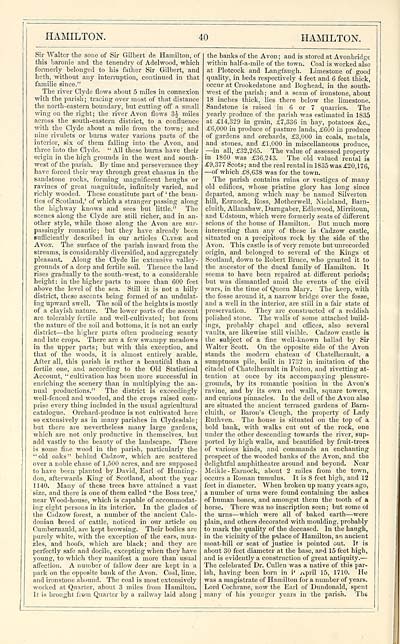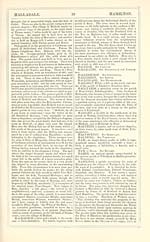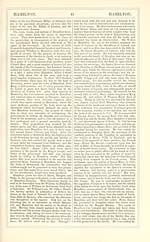Download files
Complete book:
Individual page:
Thumbnail gallery: Grid view | List view

HAMILTON.
40
HAMILTON.
Sir Walter the sone of Sir Gilbert de Hamilton, of
this baronie and the tenendry of Adelwood, which
formerly belonged to his father Sir Gilbert, and
heth, without any interruption, continued in that
familie since."
The river Clyde flows about 5 miles in connexion
with the parish; tracing over most of that distance
the north-eastern boundary, but cutting off a small
wing on the right; the river Avon flows 3 J miles
across the south-eastern district, to a confluence
with the Clyde about a mile from the town; and
nine rivulets or burns water various parts of the
interior, six of them falling into the Avon, and
three into the Clyde. " All these bums have their
origin in the high grounds in the west and south-
west of the parish. By time and perseverance they
have forced their way through great chasms in the
sandstone rocks, forming magnificent heughs or
ravines of great magnitude, infinitely varied, and
richly wooded. These constitute part of ' the beau-
ties of Scotland,' of which a stranger passing along
the highway knows and sees but little." The
scenes along the Clyde are still richer, and in an-
other style, while those along the Avon are sur-
passingly romantic; but they have already been
sufficiently described in our articles Clyde and
Avon. The surface of the parish inward from the
streams, is considerably diversified, and aggregately
pleasant. Along the Clyde lie extensive valley-
grounds of a deep and fertile soil. Thence the land
rises gradually to the south-west, to a considerable
height: in the higher parts to more than 600 feet
above the level of the sea. Still it is not a hilly
district, these ascents being formed of an undulat-
ing upward swell. The soil of the heights is mostly
of a elayish nature. The lower parts of the ascent
are tolerably fertile and well-cultivated ; but from
the nature of the soil and bottoms, it is not an early
district — the higher parts often producing scanty
and late crops. There are a few swampy meadows
in the upper parts; but with this exception, and
that of the woods, it is almost entirely arable.
After all, this parish is rather a beautiful than a
fertile one, and according to the Old Statistical
Account, " cultivation has been more successful in
enriching the scenery than in multiplying the an-
nual productions." The district is exceedingly
well-fenced and wooded, and the crops raised com-
prise every thing included in the usual agricultural
catalogue. Orchard-produce is not cultivated here
so extensively as in many parishes in Clydesdale;
but there are nevertheless many large gardens,
which are not only productive in themselves, but
add vastly to the beauty of the landscape. There
is some fine wood in the parish, particularly the
"old oaks" behind Cadzow, which are scattered
over a noble chase of 1,500 acres, and are supposed
to have been planted by David, Earl of Hunting-
don, afterwards King of Scotland, about the year
1140. Many of these trees have attained a vast
size, and there is one of them called ' the Boss tree,'
near Wood-house, which is capable of accommodat-
ing eight persons in its interior. In the glades of
the Cadzow forest, a number of the ancient Cale-
donian breed of cattle, noticed in our article on
Cumbernauld, are kept browsing. Their bodies are
purely white, with the exception of the ears, muz-
zles, and hoofs, which are black; and they are
perfectly safe and docile, excepting when they have
young, to which they manifest a more than usual
affection. A number of fallow deer are kept in a
park on the opposite bank of the Avon. Coal, lime,
and ironstone abound. The coal is most extensively
worked at Quarter, about 3 miles from Hamilton.
It is brought flora Quarter by a railway laid along
the banks of the Avon; and is stored at Avonbridge
within half-a-mile of the town. Coal is worked also
at Plotcock and Langfaugh. Limestone of good
quality, in beds respectively 4 feet and 6 feet thick,
occur at Crookedstone and Boghead, in the south-
west of the parish; and a seam of ironstone, about
18 inches thick, lies there below the limestone.
Sandstone is raised in 6 or 7 quarries. The
yearly produce of the parish was estimated in 1835
at £14,329 in grain, £7,336 in hay, potatoes fee,
£6,000 in produce of pasture lands, £600 in produce
of gardens and orchards, £3,000 in coals, metals,
and stones, and £1,000 in miscellaneous produce,
— in all, £32,265. The value of assessed property
in 1860 was £36,243. The old valued rental is
£9,377 Scots ; and the real rental in 1835 was £20, 176,
—of which £8,638 was for the town.
The parish contains ruins or vestiges of many
old edifices, whose pristine glory has long since
departed, among which may be named Silverton
hill, Earnock, Ross, Motherwell, Nielsland, Barn-
cluith, Allanshaw, Darngaber, Edlewood, Mirritoun,
and Udstoun, which were formerly seats of different
scions of the house of Hamilton. But much more
interesting than any of these is Cadzow castle,
situated on a precipitous rock by the side of the
Avon. This castle is of very remote but unrecorded
origin, and belonged to several of the Kings ot
Scotland, down to Bobert Bruce, who granted it to
the ancestor of the ducal family of Hamilton. It
seems to have been repaired at different periods;
but was dismantled amid the events of the civil
wars, in the time of Queen Maiy. The keep, with
the fosse around it, a narrow bridge over the fosse,
and a well in the interior, are still in a fair state of
preservation. They are constructed of a reddish
polished stone. The walls of some attached build-
ings, probably chapel and offices, also several
vaults, are likewise still visible. Cadzow castle is
the subject of a fine well-known ballad by Sir
Walter Scott. On the opposite side of the Avon
stands the modern chateau of Chatelherault, a
sumptuous pile, built in 1732 in imitation of the
citadel of Chatelherault in Poitou, and rivetting at-
tention at once by its accompanying pleasure-
grounds, by its romantic position in the Avon's
ravine, and by its own red walls, square towers,
and curious pinnacles. In the dell of the Avon also
are situated the ancient terraced gardens of Barn-
elm th, or Baron's Cleugh, the property of Lady
Buthven. The house is situated on the top of a
bold bank, with walks cut out of the rock, one
under the other descending towards the river, sup-
ported by high walls, and beautified by fruit-trees
of various kinds, and commands an enchanting
prospect of the wooded banks of the Avon, and the
delightful amphitheatre around and beyond. Near
Meikle- Earnock, about 2 miles from the town,
occurs a Boman tumulus. It is 8 feet high, and 12
feet in diameter. AVhen broken up many years ago,
a number of urns were found containing the ashes
of human bones, and amongst them the tooth of a
horse. There was no inscription seen; but some ot
the urns — which were all of baked earth — were
plain, and others decorated with moulding, probably
to mark the quality of the deceased. In the haugh,
in the vicinity of the palace of Hamilton, an ancient
moat-hill or seat of justice is pointed out. It is
about 30 feet diameter at the base, and 15 feet high,
and is evidently a construction of great antiquity. —
The celebrated Dr. Cullen was a native of this par-
ish, having been born in i' j»pril 15, 1710. He
was a magistrate of Hamilton for a number of years.
Lord Cochrane, now the Earl of Dundonald, spent
many of his younger years in the parish. The
40
HAMILTON.
Sir Walter the sone of Sir Gilbert de Hamilton, of
this baronie and the tenendry of Adelwood, which
formerly belonged to his father Sir Gilbert, and
heth, without any interruption, continued in that
familie since."
The river Clyde flows about 5 miles in connexion
with the parish; tracing over most of that distance
the north-eastern boundary, but cutting off a small
wing on the right; the river Avon flows 3 J miles
across the south-eastern district, to a confluence
with the Clyde about a mile from the town; and
nine rivulets or burns water various parts of the
interior, six of them falling into the Avon, and
three into the Clyde. " All these bums have their
origin in the high grounds in the west and south-
west of the parish. By time and perseverance they
have forced their way through great chasms in the
sandstone rocks, forming magnificent heughs or
ravines of great magnitude, infinitely varied, and
richly wooded. These constitute part of ' the beau-
ties of Scotland,' of which a stranger passing along
the highway knows and sees but little." The
scenes along the Clyde are still richer, and in an-
other style, while those along the Avon are sur-
passingly romantic; but they have already been
sufficiently described in our articles Clyde and
Avon. The surface of the parish inward from the
streams, is considerably diversified, and aggregately
pleasant. Along the Clyde lie extensive valley-
grounds of a deep and fertile soil. Thence the land
rises gradually to the south-west, to a considerable
height: in the higher parts to more than 600 feet
above the level of the sea. Still it is not a hilly
district, these ascents being formed of an undulat-
ing upward swell. The soil of the heights is mostly
of a elayish nature. The lower parts of the ascent
are tolerably fertile and well-cultivated ; but from
the nature of the soil and bottoms, it is not an early
district — the higher parts often producing scanty
and late crops. There are a few swampy meadows
in the upper parts; but with this exception, and
that of the woods, it is almost entirely arable.
After all, this parish is rather a beautiful than a
fertile one, and according to the Old Statistical
Account, " cultivation has been more successful in
enriching the scenery than in multiplying the an-
nual productions." The district is exceedingly
well-fenced and wooded, and the crops raised com-
prise every thing included in the usual agricultural
catalogue. Orchard-produce is not cultivated here
so extensively as in many parishes in Clydesdale;
but there are nevertheless many large gardens,
which are not only productive in themselves, but
add vastly to the beauty of the landscape. There
is some fine wood in the parish, particularly the
"old oaks" behind Cadzow, which are scattered
over a noble chase of 1,500 acres, and are supposed
to have been planted by David, Earl of Hunting-
don, afterwards King of Scotland, about the year
1140. Many of these trees have attained a vast
size, and there is one of them called ' the Boss tree,'
near Wood-house, which is capable of accommodat-
ing eight persons in its interior. In the glades of
the Cadzow forest, a number of the ancient Cale-
donian breed of cattle, noticed in our article on
Cumbernauld, are kept browsing. Their bodies are
purely white, with the exception of the ears, muz-
zles, and hoofs, which are black; and they are
perfectly safe and docile, excepting when they have
young, to which they manifest a more than usual
affection. A number of fallow deer are kept in a
park on the opposite bank of the Avon. Coal, lime,
and ironstone abound. The coal is most extensively
worked at Quarter, about 3 miles from Hamilton.
It is brought flora Quarter by a railway laid along
the banks of the Avon; and is stored at Avonbridge
within half-a-mile of the town. Coal is worked also
at Plotcock and Langfaugh. Limestone of good
quality, in beds respectively 4 feet and 6 feet thick,
occur at Crookedstone and Boghead, in the south-
west of the parish; and a seam of ironstone, about
18 inches thick, lies there below the limestone.
Sandstone is raised in 6 or 7 quarries. The
yearly produce of the parish was estimated in 1835
at £14,329 in grain, £7,336 in hay, potatoes fee,
£6,000 in produce of pasture lands, £600 in produce
of gardens and orchards, £3,000 in coals, metals,
and stones, and £1,000 in miscellaneous produce,
— in all, £32,265. The value of assessed property
in 1860 was £36,243. The old valued rental is
£9,377 Scots ; and the real rental in 1835 was £20, 176,
—of which £8,638 was for the town.
The parish contains ruins or vestiges of many
old edifices, whose pristine glory has long since
departed, among which may be named Silverton
hill, Earnock, Ross, Motherwell, Nielsland, Barn-
cluith, Allanshaw, Darngaber, Edlewood, Mirritoun,
and Udstoun, which were formerly seats of different
scions of the house of Hamilton. But much more
interesting than any of these is Cadzow castle,
situated on a precipitous rock by the side of the
Avon. This castle is of very remote but unrecorded
origin, and belonged to several of the Kings ot
Scotland, down to Bobert Bruce, who granted it to
the ancestor of the ducal family of Hamilton. It
seems to have been repaired at different periods;
but was dismantled amid the events of the civil
wars, in the time of Queen Maiy. The keep, with
the fosse around it, a narrow bridge over the fosse,
and a well in the interior, are still in a fair state of
preservation. They are constructed of a reddish
polished stone. The walls of some attached build-
ings, probably chapel and offices, also several
vaults, are likewise still visible. Cadzow castle is
the subject of a fine well-known ballad by Sir
Walter Scott. On the opposite side of the Avon
stands the modern chateau of Chatelherault, a
sumptuous pile, built in 1732 in imitation of the
citadel of Chatelherault in Poitou, and rivetting at-
tention at once by its accompanying pleasure-
grounds, by its romantic position in the Avon's
ravine, and by its own red walls, square towers,
and curious pinnacles. In the dell of the Avon also
are situated the ancient terraced gardens of Barn-
elm th, or Baron's Cleugh, the property of Lady
Buthven. The house is situated on the top of a
bold bank, with walks cut out of the rock, one
under the other descending towards the river, sup-
ported by high walls, and beautified by fruit-trees
of various kinds, and commands an enchanting
prospect of the wooded banks of the Avon, and the
delightful amphitheatre around and beyond. Near
Meikle- Earnock, about 2 miles from the town,
occurs a Boman tumulus. It is 8 feet high, and 12
feet in diameter. AVhen broken up many years ago,
a number of urns were found containing the ashes
of human bones, and amongst them the tooth of a
horse. There was no inscription seen; but some ot
the urns — which were all of baked earth — were
plain, and others decorated with moulding, probably
to mark the quality of the deceased. In the haugh,
in the vicinity of the palace of Hamilton, an ancient
moat-hill or seat of justice is pointed out. It is
about 30 feet diameter at the base, and 15 feet high,
and is evidently a construction of great antiquity. —
The celebrated Dr. Cullen was a native of this par-
ish, having been born in i' j»pril 15, 1710. He
was a magistrate of Hamilton for a number of years.
Lord Cochrane, now the Earl of Dundonald, spent
many of his younger years in the parish. The
Set display mode to: Large image | Transcription
Images and transcriptions on this page, including medium image downloads, may be used under the Creative Commons Attribution 4.0 International Licence unless otherwise stated. ![]()
| Gazetteers of Scotland, 1803-1901 > Imperial gazeteer of Scotland, or, Dictionary of Scottish topography > Volume 2 > (54) Page 40 |
|---|
| Permanent URL | https://digital.nls.uk/97471326 |
|---|
| Attribution and copyright: |
|
|---|---|

